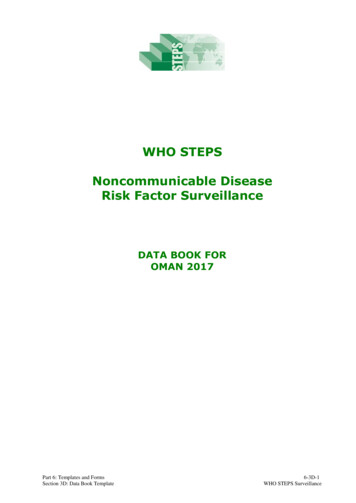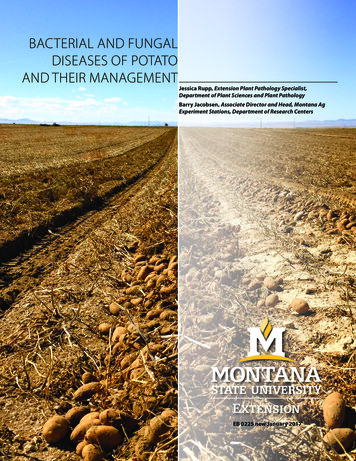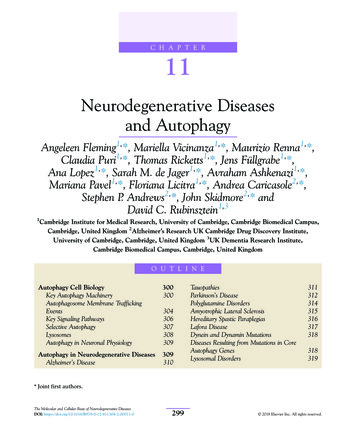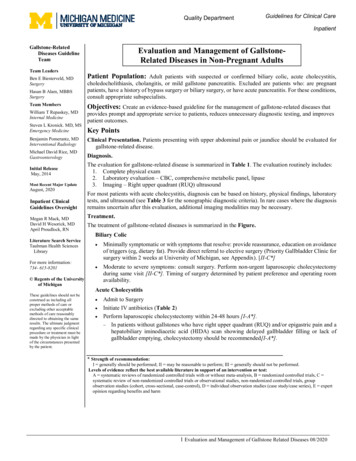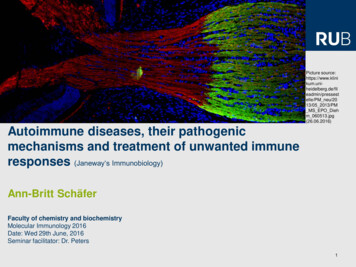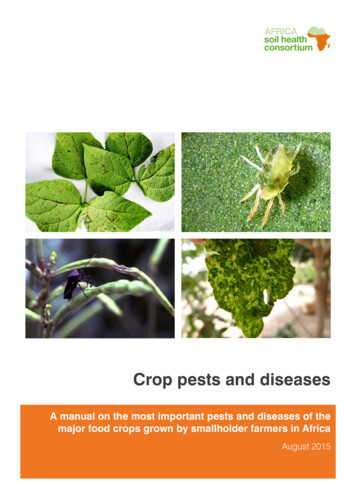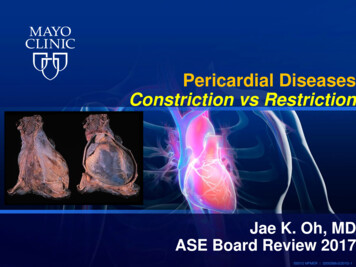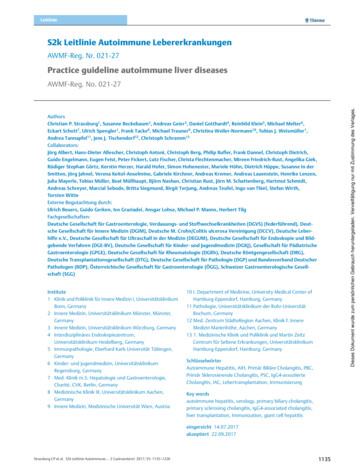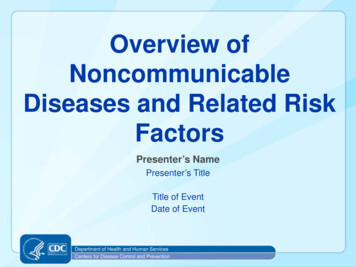
Transcription
Overview ofNoncommunicableDiseases and Related RiskFactorsPresenter’s NamePresenter’s TitleTitle of EventDate of EventDepartment of Health and Human ServicesCenters for Disease Control and Prevention
Learning ObjectivesAt the end of the training, you will be able todescribe the following for your country or region: The burden of disease of the 4 mainNoncommunicable Diseases (NCDs), and How risk factors affect the burden of NCDs.Overview of NCD’s and Risk Factors2
Lesson Overview Definition and characteristics of NCDsGlobal trends in NCDsDefinition of risk factors and metabolic risk factorsCommon risk factors for NCDsMore in-depth discussion on 4 leading NCDs, 4behavioral/lifestyle risk factors, and 4 metabolic riskfactors‒ Definition‒ Global burden‒ Health effectsOverview of NCD’s and Risk Factors3
Noncommunicable Disease(NCD): Definition Chronic conditions that do not result from an(acute) infectious process and hence are “notcommunicable.” A disease that has a prolonged course, thatdoes not resolve spontaneously, and for whicha complete cure is rarely achieved.McKenna, et al, 1998Overview of NCD’s and Risk Factors4
Characteristics of NCDs Complex etiology (causes)Multiple risk factorsLong latency periodNon-contagious origin (noncommunicable)Prolonged course of illnessFunctional impairment or disabilityOverview of NCD’s and Risk Factors5
Types of NCDs Cardiovascular disease (e.g., Coronary heartdisease, Stroke)CancerChronic respiratory diseaseDiabetesChronic neurologic disorders (e.g., Alzheimer’s,dementias)Arthritis/Musculoskeletal diseasesUnintentional injuries (e.g., from traffic crashes)http://www.who.int/gho/ncd/mortality morbidity/en/index.htmlOverview of NCD’s and Risk Factors6
Global Trends Causes of DeathsProjected Deaths in 2015 and 203030Intentional injuriesOther unintentionalRoad traffic accidentsDeaths (millions)25Other NCDs20Cancers15CVDT10Mat//peri/nutritional5Other infectiousHIV, TB, malaria0200420152030High income200420152030Middle income200420152030Low incomehttp://www.who.int/healthinfo/global burden disease/GBD report 2004update part2.pdfOverview of NCD’s and Risk Factors7
Risk Factor: Definition“An aspect of personal behavior or lifestyle, anenvironmental exposure, or a hereditarycharacteristic that is associated with an increasein the occurrence of a particular disease, injury,or other health condition.”Principles of Epidemiology, CDC, 2006Overview of NCD’s and Risk Factors8
Modifiable Risk Factor A behavioral risk factor that can be reduced orcontrolled by intervention, thereby reducing theprobability of disease. WHO has prioritized the following four:‒ Physical inactivity,‒ Tobacco use,‒ Alcohol use, and‒ Unhealthy diets (increased fat and sodium, with lowfruit and vegetable ion paper3.pdfOverview of NCD’s and Risk Factors9
Non-Modifiable Risk FactorA risk factor that cannot be reduced or controlledby intervention; for example: Age, Gender, Race, and Family history (genetics).Overview of NCD’s and Risk Factors10
Common Risk FactorsOverview of NCD’s and Risk Factors11
Metabolic Risk Factors “Metabolic" refers to the biochemical processesinvolved in the body's normal functioningBehaviors (modifiable risk factors) can lead tometabolic/physiologic changes.WHO has prioritized the following four metabolicrisk factors:‒‒‒‒Raised blood pressureRaised total cholesterolElevated glucoseOverweight and on paper3.pdfOverview of NCD’s and Risk Factors12
Knowledge Check #11. What are the 4 main NCDs that are the focus of WHO?2. Which NCD is projected to cause the most deaths by2030?3. How would you describe the difference betweenmodifiable and non-modifiable risk factors?4. What are the 4 modifiable shared risk factors?5. What are the 4 priority metabolic risk factors?Overview of NCD’s and Risk Factors13
FOUR LEADING NCDSOverview of NCD’s and Risk Factors14
WHO WebsiteGlobal Health Observatory (GHO): http://www.who.int/gho/en/ Provides data and analyses on global health priorities Noncommunicable diseases‒ Mortality/morbidity‒ Risk Factors Country statistics: health data and statistics for countriesMedia centre fact n/ Key facts Symptoms Risk factors Burden of diseaseOverview of NCD’s and Risk Factors15
Cardiovascular Disease:Definition Cardiovascular disease (CVD) is a group of disordersof the heart and blood vessels, and may include:Coronary heartdiseaseDisease of the blood vessels supplying theheart muscleCerebrovasculardisease(Stroke)Disease of the blood vessels supplying thebrainPeripheral arterialdiseaseDisease of blood vessels supplying thearms and legsCongenital heartdiseaseMalformations of heart structure existing atbirthOverview of NCD’s and Risk Factors16
Cardiovascular Disease:Definition (cont.)Overview of NCD’s and Risk Factors17
Global Burden of CardiovascularDisease CVDs are the #1 cause of death globally. An estimated 17.3 million people died from CVDs in2008. (30% of all global deaths) 7.3 million were due to coronary heart disease 6.2 million were due to stroke Over 80% CVD deaths occur in low- and middle- incomecountries. By 2030, almost 25 million people will die from CVDs.http://www.who.int/cardiovascular diseases/en/Overview of NCD’s and Risk Factors18
Cardiovascular Disease: RiskFactorsMajor modifiable risk factors- High blood pressure- Abnormal blood lipids- Tobacco use- Physical inactivity- Obesity- Unhealthy diet (salt)- DiabetesOther modifiable risk factors- Low socioeconomic status- Mental ill health (depression)- Psychosocial stress- Heavy alcohol use- Use of certain medication- Lipoprotein(a)Non-modifiable risk factors- Age- Heredity or family history- Gender- Ethnicity or race“Novel” risk factors- Excess homocysteine in blood- Inflammatory markers (Creactive protein)- Abnormal blood coagulation(elevated blood levels offibrinogen)Overview of NCD’s and Risk Factors19
Diabetes: Definition Diabetes is a disorder of metabolism— the way thebody uses digested food for growth and energy. There are 4 types: Type 1, Type 2, Gestational, andPre-Diabetes (Impaired Glucose Tolerance). Type 2 is caused by modifiable risk factors and isthe most common worldwide. 90% of all adult diabetes cases are Type 21. /2. National institute of Diabetes and Digestive and Kidney Diseases, 2012Overview of NCD’s and Risk Factors20
Diabetes: -diabetes-mellitus.htmlOverview of NCD’s and Risk Factors21
Diabetes: Burden of Disease 347 million people worldwide have diabetes. In 2004, an estimated 3.4 million people died from consequences ofhigh blood sugar. More than 80% of diabetes deaths occur in low- and middle-incomecountries. WHO projects that diabetes deaths will increase by two thirdsbetween 2008 and 2030. Healthy diet, regular physical activity, maintaining a normal bodyweight and avoiding tobacco use can prevent or delay the onset oftype 2 diabetes.1. p://www.idf.org/regionsOverview of NCD’s and Risk Factors22
Diabetes: Risk FactorsMajor modifiable Risk Factors- Unhealthy diets- Physical Inactivity- Obesity or Overweight- High Blood Pressure- High CholesterolOther Modifiable Risk Factors- Low socioeconomic status- Heavy alcohol use- Psychological stress- High consumption of sugarsweetened beverages- Low consumption of fiberNon-modifiable Risk Factors- Increased age- Family history/genetics- Race- Distribution of fatOther Risk Factors- Low birth weight- Presence of autoantibodiesOverview of NCD’s and Risk Factors23
Cancer: Definition Generic term for a large group of diseases that canaffect any part of the body. “Rapid creation of abnormal cells that grow beyondtheir usual boundaries, and which can then invadeadjoining parts of the body and spread to otherorgans.” (WHO, 2012) Benign tumors Malignant tumorsOverview of NCD’s and Risk Factors24
Cancer: Definition brary/what-is-cancerOverview of NCD’s and Risk Factors25
Global Burden of Cancer 7.6 million people died from cancer in 2008. 70% of all cancer deaths occur in low- and middleincome countries. Deaths from cancer are estimated to reach 13.1million by 2030. About 30% of cancers are attributable to behaviorrisk fs297/en/index.htmlOverview of NCD’s and Risk Factors26
Cancer EpidemiologyEstimated age-standardised incidence and mortality rates: total populationhttp://globocan.iarc.fr/Overview of NCD’s and Risk Factors27
Cervical Cancer: DefinitionCancer of the female reproductive system: Two cell types present (squamous and glandular) Tend to occur where the two cell types meet 99% of cases linked to genital infection with humanpapillomavirus (HPV)TAP Pharmaceuticals, “Female Reproductive SystemsOverview of NCD’s and Risk Factors28
Cervical CancerEstimated age-standardised rates (World) per 100,000http://globocan.iarc.fr/Overview of NCD’s and Risk Factors29
Cervical Cancer: Risk Factors Human papilloma virus infection (HPV)SmokingImmune DeficienciesPovertyNo access to PAP screeningFamily history of cervical cancerOverview of NCD’s and Risk Factors30
Lung Cancer: Definition Cancer that forms in tissues of the lung, usually inthe cells lining air passagesLeading cause of cancer death globally,1.37 milliondeaths in 2008Affects more men than womenTwo main types:‒ Small cell lung cancer‒ Non-small cell lung cancerOverview of NCD’s and Risk Factors31
Lung CancerIncidence and Mortality in 2008: Both SexesSource: http://globocan.iarc.fr/Overview of NCD’s and Risk Factors32
Lung Cancer: Risk Factors Smoking cigarettes, pipes, or cigars - now or in thepastBeing exposed to second-hand smokeBeing treated with radiation therapy to the breast orchestBeing exposed to asbestos, radon, chromium,nickel, arsenic, soot, or tarLiving where there is air pollutionOverview of NCD’s and Risk Factors33
Breast Cancer: Definition Cancer that forms in the tissues of the breast,usually in the ducts or in the lobules Occurs commonly in women, rarely occurs in men 1 of 8 women will be diagnosed with breast cancerin her lifetime.Overview of NCD’s and Risk Factors34
Breast CancerIncidence and Mortality in 2008: Both Sexeshttp://globocan.iarc.fr/Overview of NCD’s and Risk Factors35
Breast Cancer: Risk Factors Hormone therapiesWeight and physical activityRaceGenetics or family history‒ BRCA1 and BRCA2 genes Age is the most reliable risk factor!‒ Risk increases with ageOverview of NCD’s and Risk Factors36
2nd most commoncancer among menThe cancer developsinside of the prostategland.Risk factors: age,race, obesity, weightgainMortality RateProstate rview of NCD’s and Risk Factors37
Prostate CancerIncidence and Mortality in 2008: Total Populationhttp://globocan.iarc.fr/Overview of NCD’s and Risk Factors38
Colorectal Cancer 3rd most common type of cancerForms in the lower part of the digestive system(large intestine)Risk Factors include:‒‒‒‒‒AgingBlack raceUnhealthy diet and low exerciseDiabetesFamily history of colorectal r/DS00035Overview of NCD’s and Risk Factors39
Colorectal CancerIncidence and Mortality in 2008: Both Sexeshttp://globocan.iarc.fr/Overview of NCD’s and Risk Factors40
CHRONIC RESPIRATORYDISEASESOverview of NCD’s and Risk Factors41
Global Burden of ChronicRespiratory Disease A leading cause of deathHigh under-diagnoses rates90% of deaths occur in low-income countrieshttp://www.who.int/respiratory/about topic/en/index.htmlOverview of NCD’s and Risk Factors42
Chronic Respiratory Diseases: SharedRisk ld-teaching-slide-set.htmlOverview of NCD’s and Risk Factors43
COPD: Definition Chronic obstructive pulmonary diseaseCOPD – term used for lung diseases that preventproper lung airflowChronic bronchitis, emphysemaMore than just “smoker’s cough”Overview of NCD’s and Risk Factors44
COPD: Burden Accurate epidemiologic data on COPD prevalence,morbidity, and mortality are difficult and expensiveto collect.65 million people worldwide have moderate tosevere COPD.More than 3 million people died of COPD in 2005(3% of all deaths globally).Almost 90% of COPD deaths occur in low- andmiddle-income en/en/index.htmlOverview of NCD’s and Risk Factors45
Chronic Respiratory Diseases:Asthma Recurrent attacks of “breathlessness andwheezing” (WHO, 2012) A gradient of severity Can cause sleepiness, fatigue Low fatality rates, but often underdiagnosed 235 million people fs307/en/index.htmlOverview of NCD’s and Risk Factors46
Chronic Respiratory Diseases:AsthmaMedications can help control 0001196/Overview of NCD’s and Risk Factors47
Practice Exercise #11. Use the following website to determine the burden ofdisease of the 4 main NCDs in your country or tmlor http://www.who.int/gho/countries/en/2. Spend approximately 10 minutes completing theexercise.3. Be prepared to share your responses with the rest ofthe classOverview of NCD’s and Risk Factors48
RISK FACTORSOverview of NCD’s and Risk Factors49
Why Risk Factors? Surveillance for non-communicable disease can bedifficult because of: Lag time between exposure and health condition, More than one exposure for a health condition, and Exposure linked to more than one health condition. Interventions that target risk factors are needed toprevent disease.Overview of NCD’s and Risk Factors50
Risk Factor SurveillanceOverview of NCD’s and Risk Factors51
Deaths attributed to 19 leading riskfactors, by country income level, 2004WHO Global Health risks reportOverview of NCD’s and Risk Factors52
Tobacco Use Tobacco kills up to half of its users. Tobacco kills nearly 6 million people each year. Annual death toll could rise to more than 8million by 2030. Nearly 80% of the world’s 1 billion smokers livein low- and middle-income s/fs339/en/index.htmlOverview of NCD’s and Risk Factors53
Global Adult Tobacco co atlas/index.htmOverview of NCD’s and Risk Factors54
Tobacco Use: Health EffectsMathers CD, Loncar D. Projections of global mortality and burden of disease from 2002 to 2030. PLoS Medicine, 2006,3(11): e442.Overview of NCD’s and Risk Factors55
Tobacco Use: Health Effects(cont.)Among smokers: Cancer Coronary heart disease Diseases of the lungs Peripheral vasculardisease Stroke Fetal complications andstillbirthOverview of NCD’s and Risk Factors Second-hand smokecauses: Heart disease, includingheart attack Lung cancer56
DIETOverview of NCD’s and Risk Factors57
Global Changes in Diet Most countries have increased overall dailyconsumption of: Daily calories, Fat and meats, and Energy dense and nutrient-poor foods suchas:‒ Starches‒ Refined sugars‒ Trans-fatshttp://www.pitt.edu/ super4/41011-42001/41171.pdfOverview of NCD’s and Risk Factors58
Unhealthy Diet: Health Effects Coronary heart diseaseStrokeCancerType 2 diabetesHypertensionDiseases of the liver and gallbladderObesityOverview of NCD’s and Risk Factors59
PHYSICAL INACTIVITYOverview of NCD’s and Risk Factors60
Global Changes in PhysicalActivity 31% of the world’s population does not get enoughphysical activity. Many social and economic changes contribute tothis trend: Aging populations, Transportation, and Communication technology.1. lines/adults.html2. 0140673612608988Overview of NCD’s and Risk Factors61
Global Changes in PhysicalActivity (cont.)Lee IM, Shiroma EJ, Lobelo F, Puska P, Blair SN, Katzmarzyk PT; Lancet Physical Activity Series Working Group.Effect of physical inactivity on major non-communicable diseases worldwide: an analysis of burden of disease and lifeexpectancy. Lancet. 2012 Jul 21;380(9838):219-29Overview of NCD’s and Risk Factors62
Physical Activity: HealthEffectsReduces: High bloodpressure Adverse lipidprofile Arthritis pain PsychiatricissuesReduces risk of: Type 2 diabetes Certain cancers Heart attacks Stroke Falls Early rof.aspxOverview of NCD’s and Risk Factors63
HARMFUL USE OF ALCOHOLOverview of NCD’s and Risk Factors64
Global Alcohol Consumption 11.5% of all global drinkers are episodic, heavyusers. 2.5 million people die from alcoholconsumption per year The majority of adults consume at low-risklevels. Estimated worldwide consumption of alcoholhas remained relatively stable.http://www.who.int/substance abuse/publications/global alcohol report/msbgsruprofiles.pdfOverview of NCD’s and Risk Factors65
Global Alcohol Consumption(cont.)http://www.who.int/substance abuse/publications/global alcohol report/en/index.htmlOverview of NCD’s and Risk Factors66
Harmful Use of Alcohol:DefinitionExcessive drinking, per day Heavy drinking – on average Binge drinking – single occasion Overview of NCD’s and Risk Factors 67
Harmful Use of Alcohol: EffectsImmediate effects: Diminished brainfunction Loss of body heat Fetal damage Risk for unintentionalinjuries Risk for violence Coma and deathOverview of NCD’s and Risk FactorsLong-term effects: Liver diseases Cancers Hypertension Gastrointestinaldisorders Neurological issues Psychiatric issues68
Metabolic Risk FactorsWhat are the four metabolic risk factors?1. Raised Blood Pressure (Hypertension)2. Raised Cholesterol3. Raised Blood Glucose4. Overweight and ObesityOverview of NCD’s and Risk Factors69
Raised Blood Pressure Hypertension (Systolic)/(Diastolic) in mm of Hg (mercury) Systolic amount of force your arteries use when theheart pumps Diastolic amount of force your arteries use when theheart veSystolicmmHg 120120-139140 DiastolicmmHg 8080-8990 Overview of NCD’s and Risk Factors70
High Blood Pressure1. US Department of Health & Human Services, National Heart, Lung, and Blood2. http://gamapserver.who.int/gho/interactive charts/ncd/risk factors/blood pressure prevalence/atlas.htmlOverview of NCD’s and Risk Factors71
Raised Blood Pressure: HealthEffects Leading risk factor for strokeMajor risk factor for coronary heart diseaseIn some age groups, the risk of CVD doubles foreach increment of 20/10 mmHg of blood pressureOther complications of raised blood pressure:‒‒‒‒‒Heart failurePeripheral vascular diseaseRenal impairmentRetinal hemorrhageVisual impairmentOverview of NCD’s and Risk Factors72
Hypertension and ExcessiveSodium Intake Sodium, through hypertension, is a major cause ofcardiovascular disease deaths and disability. About 10% of cardiovascular disease is caused byexcess sodium intake. 8.5 million deaths could be prevented over 10 yearsif sodium intake were reduced by 15%.Overview of NCD’s and Risk Factors73
Sources of Sodium People are unaware of how much dietary sodiumthey are eating. In the U.S. 75% of sodium consumed comes fromprocessed and restaurant foods. In China and Japan, 75% of sodium consumedcomes from cooking with high sodium products.Overview of NCD’s and Risk Factors74
Recommendations and ActualIntakes WHO/PAHO Recommendations A population salt intake of less than 5 grams orapproximately 2,000 milligrams of sodium, per person perday is recommended to reach national targets or in theirabsence. This level was recommended for the preventionof cardiovascular diseases.Actual Intake Latest global estimates show that average sodium intakevaries from 2,000 to 7,200 milligrams of sodium perperson per day.Overview of NCD’s and Risk Factors75
Raised Total CholesterolHDL: High density lipoproteins; often called “good cholesterol”LDL: Low density lipoproteins; often called “bad cholesterol”VLDL: Very low density lipoproteins; has highest amount oftriglyceridesTriglycerides: Type of fat found in your blood (stored in fat cells)Overview of NCD’s and Risk Factors76
Global Burden of Raised TotalCholesterol In 2008, global prevalence of raised totalcholesterol among adults ( 5.0 mmol/l) was 39%(37% for males and 40% for females). Estimated to cause 2.6 million deaths. What is the prevalence of raised total cholesterol inyour country? Search the WHO Global Health Observatory website:http://www.who.int/gho/ncd/risk factors/en/index.htmlOverview of NCD’s and Risk Factors77
Raised Total Cholesterol: HealthEffects Increases risks of heart disease and stroke Globally, 1/3 of ischaemic heart disease is attributable tohigh cholesterol A 10% reduction in serum cholesterol in men aged 40 hasbeen reported to result in a 50% reduction in heart diseasewithin 5 years A 10% reduction in serum cholesterol in men aged 70years can result in an average 20% reduction in heartdisease occurrence in the next 5 yearshttp://www.who.int/gho/ncd/risk factors/cholesterol text/en/Overview of NCD’s and Risk Factors78
Elevated Glucose Sugar produces fuel and energy for our cellsInsulin helps control the amount of glucose in ourbodiesOverview of NCD’s and Risk Factors79
Global Burden of ElevatedGlucose In 2004, it was estimated that elevated glucoseresulted in 3.4 million deaths (5.8% of all deaths). Globally, approximately 9% of adults aged 25 andover had elevated blood glucose in 2008.Overview of NCD’s and Risk Factors80
Elevated Glucose:Health Effects Elevated glucose levels can lead to type 2diabetes. Diabetes: leading cause of renal failure Lower limb amputations are at least 10 times morecommon in people with diabetes than in non-diabeticpeople Raised glucose is a major cause of heart diseaseand renal disease.Overview of NCD’s and Risk Factors81
Overweight and Obesity Overweight and obesity are defined as ''abnormal orexcessive fat accumulation that presents a risk tohealth.” (1) BMI - the Body Mass IndexBMI (weight in kg)/(height in meters, squared)- Between 25 and 29.9 indicates overweight- 30 or higher indicates obesity Skinfold Thickness Test Waist-to-Hip Circumference Ratio‒ Men 102 cm are considered high risk‒ Women 88 cm are considered high risk1. http://www.who.int/dietphysicalactivity/childhood what/en/index.htOverview of NCD’s and Risk Factors82
Overweight and Obesity: GlobalBurden Worldwide, obesity has more than doubled since 1980. In 2008, more than 1.4 billion adults, 20 and older, wereoverweight.‒ Of these, 200 million men and nearly 300 million women wereobese. 65% of the world’s population live in countries where themortality associated with overweight and obesity is higherthan the mortality associated with underweight. Globally, in 2010 the number of overweight children under theage of five was estimated to be over 42 million.‒ Close to 35 million of these are living in developing countries.http://www.who.int/healthinfo/global burden disease/2004 report update/en/index.htmlOverview of NCD’s and Risk Factors83
Overweight and Obesity: HealthEffects Environment, lifestyle, genetics, and otherfactors contribute to each individual’s risk forbeing overweight or obese. Increases risk of coronary heart disease, type 2diabetes, and hypertension Large economic consequences for manycountries tp://www.thelancet.com/series/obesityOverview of NCD’s and Risk Factors84
2012 WHO Global Targets:Reducing Risk r2012 PPT RevPaper TA.pdfOverview of NCD’s and Risk Factors85
Knowledge Check #21. What percentage of cancers is attributable tobehavioral risk factors?2. Approximately what percentage of the world’spopulation does not get enough physical activity?3. What percentage of the major NCDs worldwide isattributable to physical inactivity?4. Tobacco is a risk factor for how many of the leadingcauses of death in the world?5. Approximately what percentage of CVD is causedby excessive sodium intake?Overview of NCD’s and Risk Factors86
Practice Exercise #21. You will work individually or in pairs to answer thefollowing questions: Which 2 behavioral risk factors or metabolic riskfactors have the highest prevalence in your country? On which risk factors would you focus prevention andcontrol efforts? How would focusing on these risk factors effect theprevalence of NCDs in your country?2. Spend approximately 45 minutes completing theexercise.3. Be prepared to share your responses with the rest ofthe class.Overview of NCD’s and Risk Factors87
APPENDIXOverview of NCD’s and Risk Factors88
Stomach Cancer: Definition There are many forms of stomach cancerAdenocarcinoma- cell type lining the stomachOverview of NCD’s and Risk Factors89
Stomach CancerIncidence and Mortality in 2008: Both Sexeshttp://globocan.iarc.fr/Overview of NCD’s and Risk Factors90
Stomach Cancer: Risk Factors SmokingFamily history of stomach cancerHelicobacter pylori infections, ulcers or polypsDiet‒ High salt foods, smoked foods, and pickled foodsOverview of NCD’s and Risk Factors91
Liver Cancer: Definition Cancer that forms in the liver or spreads fromthe liver to other areas of the body Few early signs of liver cancer Several types of liver cancer existOverview of NCD’s and Risk Factors92
Liver CancerIncidence and Mortality in 2008: Both Sexeshttp://globocan.iarc.fr/Overview of NCD’s and Risk Factors93
Liver Cancer: Risk Factors SexAgeChronic hepatitis infectionsDiabetesCirrhosisHeavy alcohol consumptionObesityOverview of NCD’s and Risk Factors94
Centers for Disease Control and Prevention (CDC). Overview ofNCD’s and Risk Factors. Atlanta, Georgia: Centers for DiseaseControl and Prevention (CDC); 2013.Overview of NCD’s and Risk Factors95
For more information please contact Centers for Disease Control and Prevention1600 Clifton Road NE, Atlanta, GA 30333Telephone: 1-800-CDC-INFO (232-4636)/TTY: 1-888-232-6348Visit: www.cdc.gov Contact CDC at: 1-800-CDC-INFO or www.cdc.gov/infoThe findings and conclusions in this report are those of the authors and do not necessarily represent the official positionof the Centers for Disease Control and Prevention.Department of Health and Human ServicesCenters for Disease Control and Prevention96
Overview of NCD’s and Risk Factors . Global Trends Causes of Deaths. Projected Deaths in 2015 and 2030 . 0 5 10
